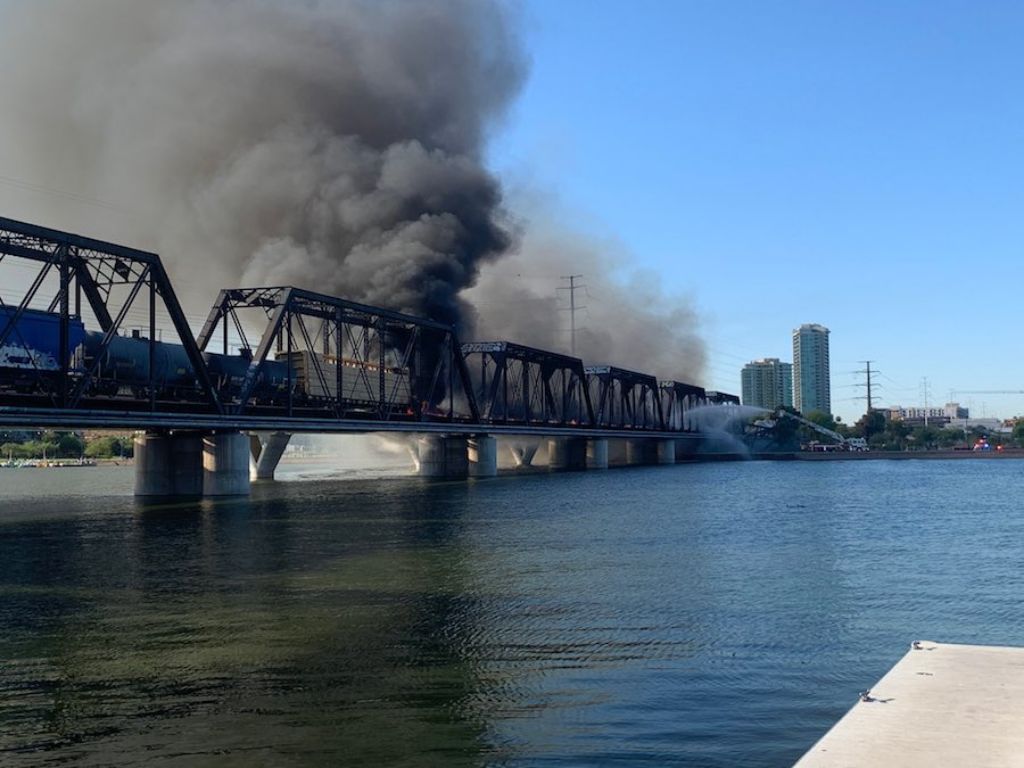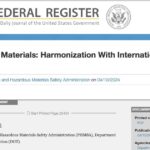Originally published on ENR

The southern portion of a 100-year-old bridge over the Salt River in Tempe, Ariz., collapsed after a July 29 train derailment that caused chemicals to leak from several railcars at the scene.
According to Union Pacific officials, at around 6:15 a.m. PDT, the Union Pacific freight train derailed, and eight to 10 rail cars caught fire. There were no injuries among the train crew members, although one person was treated for smoke inhalation.
Rail cars fell underneath the collapsed portion of the bridge, including three tank cars, company spokesman Tim McMahan said in a statement. Two cars were transporting cyclohexanone, an organic compound often used in the making of nylon, and one contained a rubber material. Union Pacific estimates that 500 gallons of cyclohexanone leaked from one of the tank cars.
Tempe officials reported late on July 29 that HAZMAT crews had sprayed a layer of foam over the car to keep it cool and help manage any vapors, but cyclohexanone leaked into a storm drain that empties into the riverbed on the west side of a dam.
By July 30, the Tempe Police Dept. and Tempe Fire Medical, as well as state and federal partners, said the chemical leak had been contained and did not pose a public health threat.
The rail line’s emergency response team is working at the scene with local and federal authorities to determine the cause of the derailment. The city says it does not manage or inspect the train track, which is owned and operated by Union Pacific.
“There’s always an initiating cause to a bridge failure. This bridge has been here for 100 years; why did that happen?” says Michael J. Chajes, bridge engineering expert and on the faculty of the Dept. of Civil and Environmental Engineering at the University of Delaware. “We know that either the train derailed, causing the bridge to collapse, or the bridge collapsed, causing the train to derail. Those are the two options.”
Tempe Fire Medical Rescue responded only a month ago to another derailment at the same location, resulting in a small fire and some debris on nearby Rio Salado Parkway. McMahan said the incident, which happened June 26, derailed nearly 12 Union Pacific railcars, damaging the rails and bridge ties. The rail firm made repairs and the line reopened on June 28.
“I would be interesting to know where that happened and what was learned from that,” given that the initial derailment happened as recently as late June, Chajes says. “The only thing I would ask is if there are any correlations—if it happened a month ago, why is it happening again? What was the cause a month ago? And should that have tipped us off that there was some susceptibility of this happening again?”
This type of bridge failure isn’t common. Railway bridges are “really sturdily built” and inspected on a regular basis, and the collapse of a railway bridge due to a component failure is not common, he says.
“My speculation would be more that the train impacted the bridge and caused it to fail. Trains derail at times, but there’s a lot of track. So the miles of tracks versus the miles of tracks on bridges is pretty small. Trains don’t derail that often, and then when they do derail, their probability of doing it on a bridge is pretty low,”Chajes says.
Temperature could have played a role in the Tempe accident. It was 106° F in Tempe when the derailment occurred, Chajes notes. “One possibility is certainly that there was a buckle in the track and that caused the train to derail.”
The investigation is likely to proceed fairly quickly, but the evaluation of the event and the issuance of a report detailing what exactly happened will take time, he says.
“The one thing I always tell people, even though it makes a lot of headlines when there’s a failure like this, is that in the scheme of the 500,000 to 600,000-plus bridges we have in the country, it’s an infrequent event,” Chajes says. “Probability-wise, bridges are maintained fairly well. I think we never feel we have enough funds to do as much as we would like to, but still, they’re designed conservatively and this is sort of a freak event.”
The railway bridge across the Salt River has been in place since 1887, according to the city of Tempe. A portion of the bridge collapsed due to flooding in 1890, was repaired, then washed away in a flood a year later.
After the bridge was rebuilt, sections collapsed again in 1902, causing parts of a train to fall into the riverbed. Although there was no flood at the time, it is thought that the bridge had been gradually weakened by flood waters. The bridge was rebuilt in 1912 and has remained in place since.










